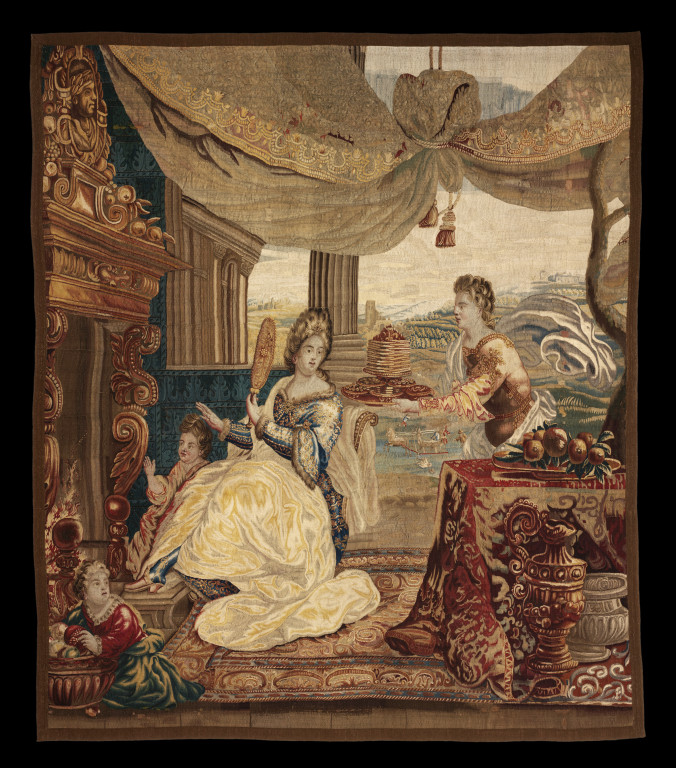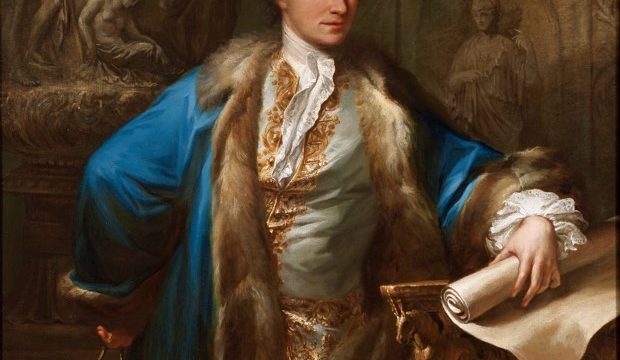While a steady rhythm of cold rain continues tapping on the Museum windows, there are a number of objects going into the galleries that provide a satisfying suggestion of warmth and comfort.
Most notably, there is the lucky lady depicted in this large Flemish tapestry warming herself by a large fire and being brought a large plate of sweetmeats.

Depicting Winter, this tapestry was one of a set representing the four Seasons. It shows a scene of warmth, luxury and comfort to contrast with the winter weather outside.
The elegant lady warms herself by a roaring fire, using a fan to protect her face and preserve her pale complexion. A pale complexion was then valued as a sign that you didn’t work in the fields or expose your skin to extreme weather conditions – and therefore belonged to the upper social classes.

She is surrounded with objects demonstrating her wealth; whilst outside skaters and sledgers can be seen making their way across a frozen river.

On a smaller scale, an object that I can imagine providing much comfort to its owner is this small foot-warmer. I’d love to have one of these under my desk to pop my feet on.

In the 17th and 18th centuries, nearly every Dutch home would have had one or more foot-warmers, or ‘foot stoves’. These small perforated boxes held a receptacle containing hot coals and were used to keep feet and legs warm during the long Dutch winters. They can frequently be spotted in paintings of Dutch interiors, including those of Vermeer.


However, my favourite demonstration a foot warmer in use is definitely that found in Willem van Mieris’ painting from 1719.


The motif of a foot warmer featured in Sinnepoppen, an emblem book by Roemer Visscher, which called it a Mignon des Dames (the Ladies Sweetheart). It described how, during the winter, women loved their warmers more than anything else and that if a man were to come along, he could at best take second place.
This neatly brings us to my final ‘warming object’ in this post – an early 17th century warming pan.
On a cold winter’s night there’s nothing quite like having a nice pre-warmed bed waiting for you. Before the days of central heating, hotwater bottles or electric blankets, people used warming pans to warm up their beds before getting in. These pans were filled with hot coals or embers and then passed between the sheets using the long handle attached to the pan. Some skill and dexterity were needed to ensure that the sheets would not be scorched.
Like foot-warmers, warming pans can frequently be found in 17th- and 18th-century paintings of Dutch interiors. You will see that Mieris’ monkeys (in the painting above) have their own warming pan hanging ready next to the bed. A particularly charming example can also be seen in Pieter de Hooch’s ‘Mother lacing her bodice beside a cradle’.

If you visit the Museum of Childhood at Bethnal Green you can also try to spot this tiny warming pan which is part of a miniature Dutch kitchen, housed in a cabinet, believed to date from the late 17th century.


Our (full-size!) example, that will be in the Europe Galleries, is decorated with a depiction of Venus and Cupid signifying love, but is accompanied by a somewhat amusing inscription (in Dutch) stating that:
‘This pan is suited for women who like to sleep in a warm bed and who have nobody to warm them, so they have to fire their bed by means of a pan if they haven’t got a man who can warm their feet for them’.



I prefer modern gadgets
I really like ur article n I have learned alot from this post